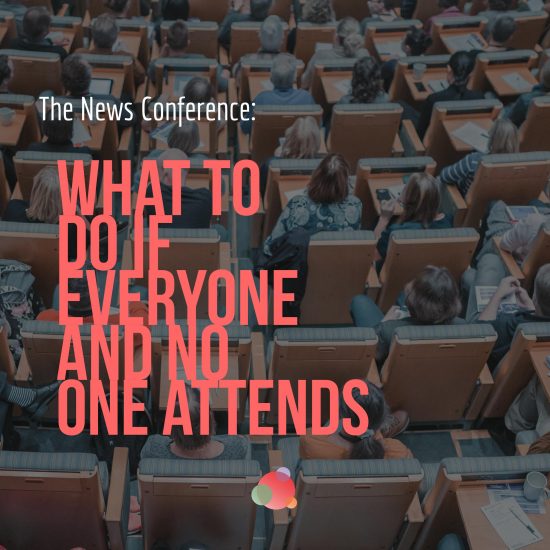
Despite this being an increasingly online world, where we can order everything we need and never leave the house, there is still a role for the traditional news conference in the media relations mix.
Journalists, and by extension, the public, still want to hear directly from the source on important topics, decisions, and actions which impact their lives.
Having kicked around communications for more than 35 years (yes, I started when I was five, thanks for asking!), I have experienced the highs and lows of news conferences.
Until you’ve lived through situations where everyone (including cable news on live remote) and no one (*crickets*) attends, it’s hard to anticipate what to do in these extremes.
Especially if, in both instances, you had planned local, community-based announcements.
News Conference: Plan for 10…Dozens Show Up
Several years ago, our client wanted to announce a new community-based initiative to help encourage diversity and inclusion.
We developed a program based on nurturing mutual respect for people of different backgrounds, ethnicities, and religions.
To roll this program out, the client agreed to a media launch, and we invited a few politicians who also supported these ideals to lend their voice to the announcement.
In our city, there’s a core of 15 media outlets, and on any given day, around 10 reporters will attend.
However, 20 minutes before the start of the event, dozens of reporters started rolling in.
Yippee, we thought as we patted ourselves on the back.
We exceeded our target for attendance!
Then, as more reporters arrived, including a cable news network with a live remote, we started to realize that maybe they weren’t just here for our story.
Ahem.
It turns out, the media were willing to patiently sit through our announcement to corner one of the politicians on an emerging government issue.
The nerve!
Having invaded our event, most of the reporters didn’t even bother to file a story on our initiative.
Insult to injury!
What to Do if This Happens to Your News Conference
Before the event begins:
- Immediately touch base with the politician’s entourage to find out what the reporters are looking for.
- Find out who in the entourage will deal with the reporters, and whether the politician plans to make a statement or ignore reporters.
- Jointly announce to reporters what is going to happen: our event first (which we know you will cover! Hint, hint.), and then the politician’s staff will allow a scrum… or whatever they decide. Tell them they can do this from a distance—outside your news conference room, down the hall, etc. In our case, we were in a public space, so we could not ask them to leave outright.
After the event:
- Connect with those reporters you believe are interested in your story. Spend time facilitating one-on-one interviews with the speakers. Follow up with any additional resources or information.
Bottom line:
You can’t stop the media from pursuing other stories when they’re at your event, but you can control how and when they take attention away from your announcement.
Focus on the reporters who are genuinely interested in your story, and ask the reporters chasing the politician to do so from a distance.
When Only You and Your Client Attend the News Conference
Ack! Is there anything more awkward than having no one show up?!
This happened to me, and I’m sure it has happened to others, especially if there’s a breaking story that has diverted media attention away.
It’s your worst nightmare.
You and your client are planning a major announcement.
You sent media invitations.
News releases, backgrounders, and digital assets are ready and assembled.
Coffee and donuts anxiously await the first guest.
The clock inches closer and closer to the posted start time.
Nothing.
Not one person shows up.
Gulp.
What to Do??
- First, remind your client that media coverage is never a guarantee. Hollow words at the moment, I’m sure, but it’s a fact. You are quickly forgotten if a major news event happens at the same time.
- Send the materials via courier to each media outlet, along with a note saying you’re sorry they missed the announcement. Enclose all the materials, two or three different storylines they might want to consider, and a list of speakers/experts they may want to interview by phone.
- Be as helpful and friendly to media as possible, and let them know you understand how the industry works.
- If your announcement is not time-sensitive, see if you can book the client on a morning TV or radio show, or arrange a one-on-one interview at an interesting location (your plant, a retailer carrying your product, a park where you can demonstrate your product, etc.).
Bottom line:
You’ll have to work extra hard to get even a couple of stories out.
These are usually higher quality than what is garnered from a news conference because you’ll have taken extra time and individual attention to facilitate media coverage.
Has this happened to you?
How did you handle it?
What other tips would you add?
Please share in the comments below.